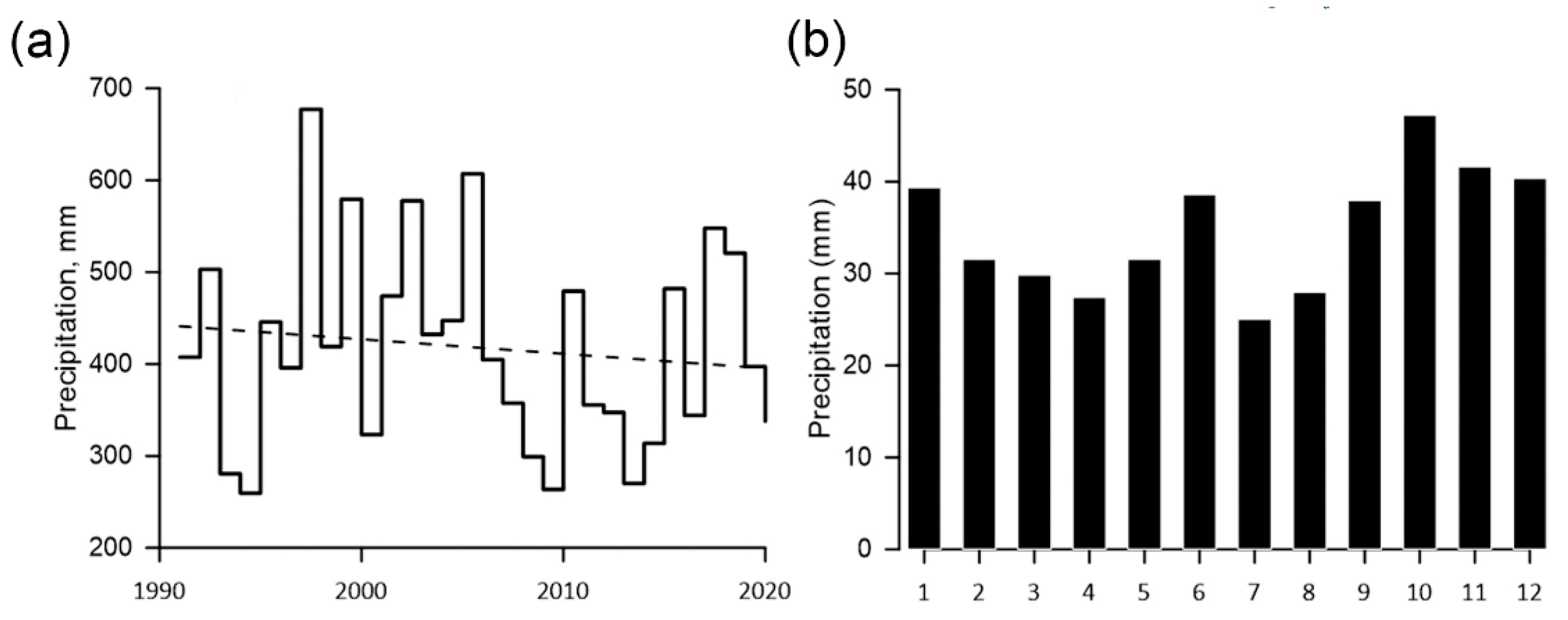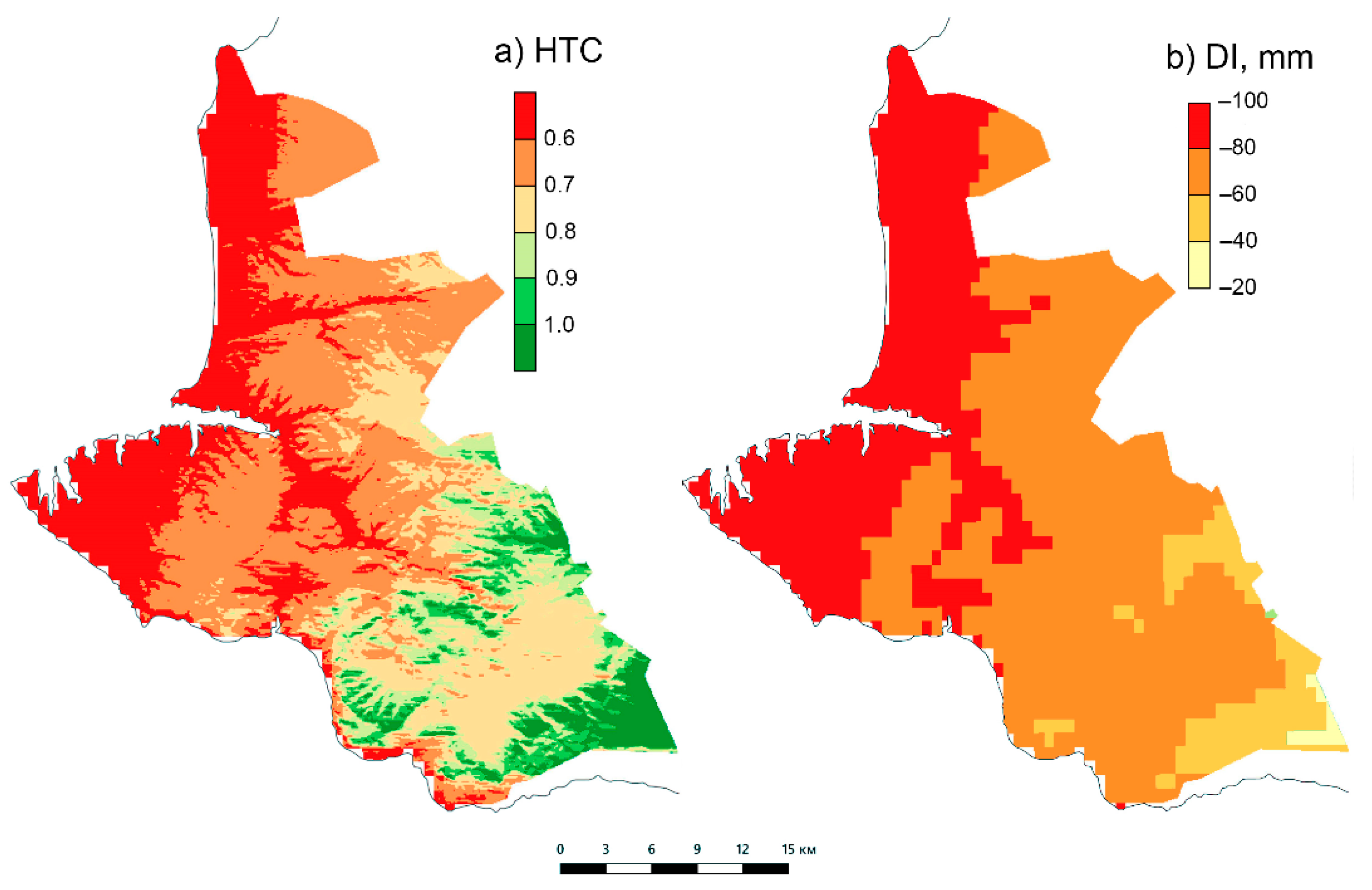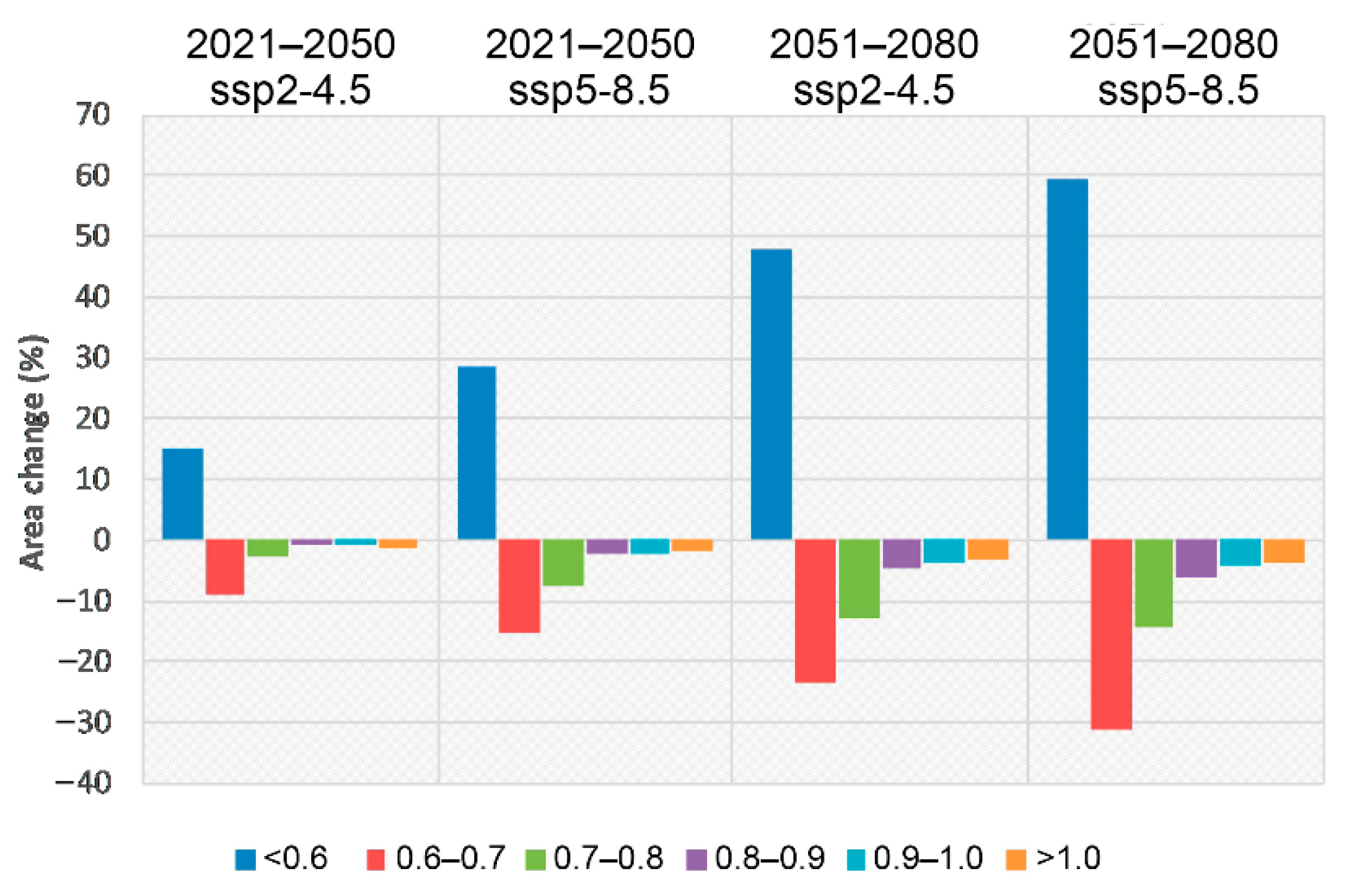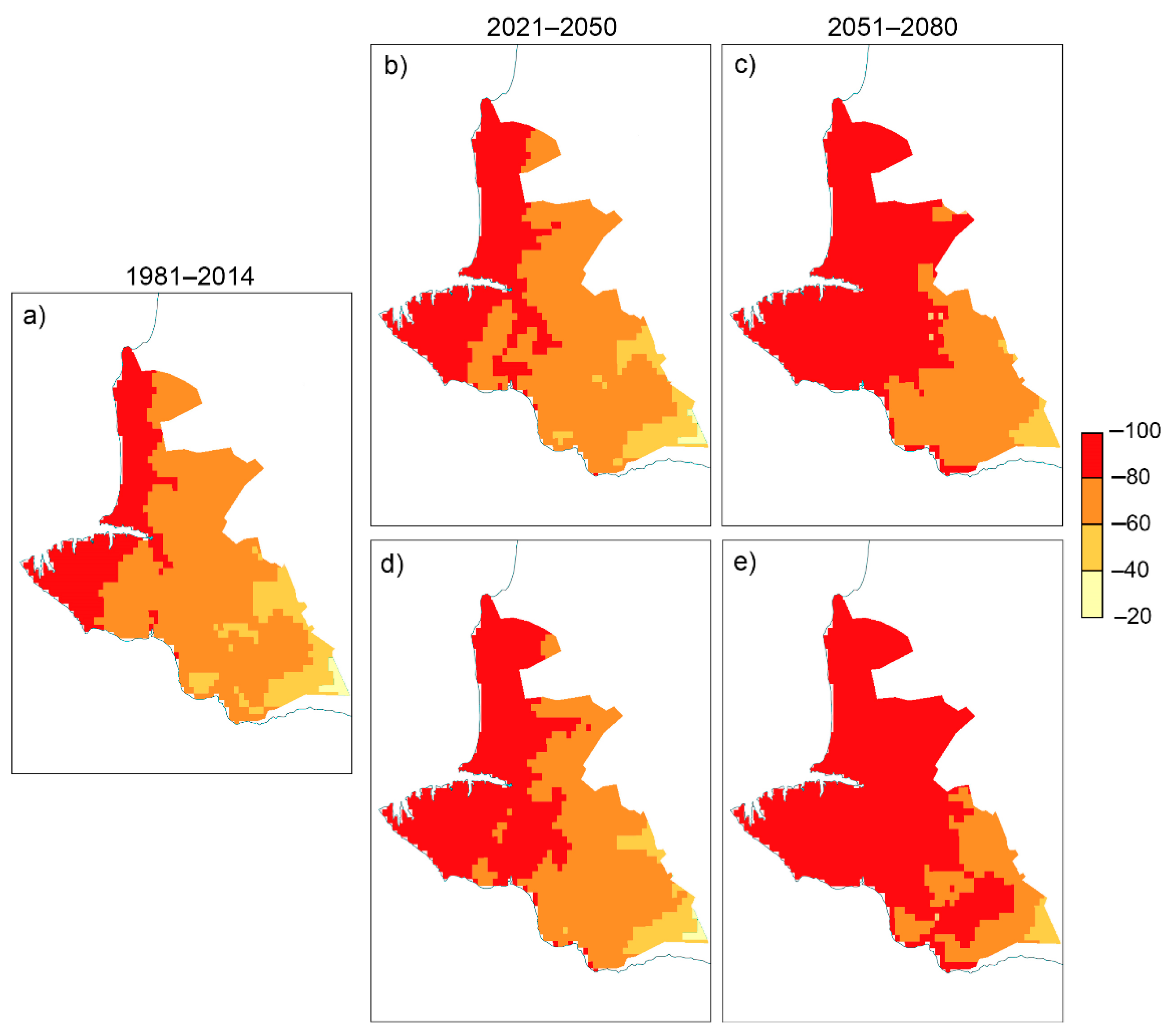Assessment of the Current and Projected Conditions of Water Availability in the Sevastopol Region for Grape Growing
Abstract
:1. Introduction
2. Materials and Methods
2.1. Study Area
2.2. Data and Methods
- -
- the annual precipitation (in mm);
- -
- the average growing season precipitation [48]. It is determined as the sum of precipitation during the growing season (between April and October for the Northern hemisphere). It provides information on the effect of precipitation during this period on the phenology and ripening of grape berries, which affects the quality of grapes and the health of the vine [49];
- -
- -
- the dryness index, or DI [51]. The DI is a climate index used in viticulture to characterize the water component of a region. It is closely related to the quality of grapes and wine [52]. The index takes into account the climatic requirements of the vineyard, evaporation from open soil, and rainfall without deducting surface runoff or drainage. It indicates the potential availability of water in soil related to the level of aridity in the region (see Table 2).
3. Results
3.1. Current Water Availability of the Sevastopol Region
3.2. Prognostic Evaluations
3.2.1. Comparing the Observational and Model Data
3.2.2. Selyaninov`s Hydrothermal Coefficient (HTC)
3.2.3. Dryness Index (DI)
4. Discussion and Conclusions
Author Contributions
Funding
Data Availability Statement
Conflicts of Interest
References
- Venios, X.; Korkas, E.; Nisiotou, A.; Banilas, G. Grapevine Responses to Heat Stress and Global Warming. Plants 2020, 9, 1754. [Google Scholar] [CrossRef]
- Fraga, H.; Pinto, J.G.; Santos, J.A. Climate change projections for chilling and heat forcing conditions in European vineyards and olive orchards: A multi-model assessment. Clim. Chang. 2019, 152, 179–193. [Google Scholar] [CrossRef]
- Gutiérrez-Gamboa, G.; Zheng, W.; de Toda, F.M. Current viticultural techniques to mitigate the effects of global warming on grape and wine quality: A comprehensive review. Food Res. Int. 2020, 139, 109946. [Google Scholar] [CrossRef] [PubMed]
- Bois, B.; Joly, D.; Quénol, H.; Pieri, P.; Gaudillère, J.-P.; Guyon, D.; Saur, E.; Van Leeuwen, C. Temperature-based zoning of the Bordeaux wine region. OENO One 2018, 52, 291–306. [Google Scholar] [CrossRef]
- Jones, G.V.; White, M.; Cooper, O.R.; Storchmann, K. Climate Change and Global Wine Quality. Clim. Chang. 2005, 73, 319–343. [Google Scholar] [CrossRef]
- Neethling, E.; Barbeau, G.; Coulon-Leroy, C.; Quénol, H. Spatial complexity and temporal dynamics in viticulture: A review of climate-driven scales. Agric. For. Meteorol. 2019, 276–277, 107618. [Google Scholar] [CrossRef]
- Bernáth, S.; Paulen, O.; Šiška, B.; Kusá, Z.; Tóth, F. Influence of Climate Warming on Grapevine (Vitis vinifera L.) Phenology in Conditions of Central Europe (Slovakia). Plants 2021, 10, 1020. [Google Scholar] [CrossRef]
- Di Carlo, P.; Aruffo, E.; Brune, W.H. Precipitation intensity under a warming climate is threatening some Italian premium wines. Sci. Total. Environ. 2019, 685, 508–513. [Google Scholar] [CrossRef]
- Wolkovich, E.M.; De Cortázar-Atauri, I.G.; Morales-Castilla, I.; Nicholas, K.A.; Lacombe, T. From Pinot to Xinomavro in the world’s future wine-growing regions. Nat. Clim. Chang. 2018, 8, 29–37. [Google Scholar] [CrossRef]
- Santos, J.A.; Fraga, H.; Malheiro, A.C.; Moutinho-Pereira, J.; Dinis, L.-T.; Correia, C.; Moriondo, M.; Leolini, L.; DiBari, C.; Costafreda-Aumedes, S.; et al. A Review of the Potential Climate Change Impacts and Adaptation Options for European Viticulture. Appl. Sci. 2020, 10, 3092. [Google Scholar] [CrossRef]
- Seguin, G. L’alimentation en eau de la vigne dans des sols du Haut-Médoc. OENO One 1969, 3, 93–141. [Google Scholar] [CrossRef]
- van Leeuwen, C. Terroir: The effect of the physical environment on vine growth, grape ripening and wine sensory attributes. In Managing Wine Quality. Viticulture and Wine Quality; Woodhead Publishing Series in Food Science; Technology and Nutri-tion; Elsevier: Amsterdam, The Netherlands, 2010; pp. 273–315. [Google Scholar] [CrossRef]
- Gladstones, J. Wine, Terroir and Climate Change; Wakefield Press: Kent Town, Australia, 2011; 280p. [Google Scholar]
- Novikova, L.Y.; Naumova, L.G. Dependence of Fresh Grapes and Wine Taste Scores on the Origin of Varieties and Weather Conditions of the Harvest Year in the Northern Zone of Industrial Viticulture in Russia. Agronomy 2020, 10, 1613. [Google Scholar] [CrossRef]
- Jones, G.V.; Davis, R.E. Climate Influences on grapevine phenology, grape composition, and wine production and quality for Bordeaux, France. Am. J. Enol. Vitic. 2000, 51, 249–261. [Google Scholar]
- Lorenzo, M.N.; Taboada, J.; Lorenzo, J.F.; Ramos, A. Influence of climate on grape production and wine quality in the Rías Baixas, north-western Spain. Reg. Environ. Chang. 2013, 13, 887–896. [Google Scholar] [CrossRef]
- Shaw, T.B. Climate change and the evolution of the Ontario cool climate wine regions in Canada. J. Wine Res. 2016, 28, 13–45. [Google Scholar] [CrossRef]
- Cook, B.I.; Wolkovich, E.M. Climate change decouples drought from early wine grape harvests in France. Nat. Clim. Chang. 2016, 6, 715–719. [Google Scholar] [CrossRef]
- De Orduña, R.M. Climate change associated effects on grape and wine quality and production. Food Res. Int. 2010, 43, 1844–1855. [Google Scholar] [CrossRef]
- Wheeler, S.J.; Pickering, G.J. The effects of soil management techniques on grape and wine quality. In Fruits: Growth, Nutrition and Quality; Dris, R., Ed.; Meri-Rastilan tie 3 C; WFL Publisher: Helsinki, Finland, 2006; pp. 195–208. ISBN 978-952-99555-0-3. [Google Scholar]
- Tzortzakis, N.; Chrysargyris, A.; Aziz, A. Adaptive Response of a Native Mediterranean Grapevine Cultivar Upon Short-Term Exposure to Drought and Heat Stress in the Context of Climate Change. Agronomy 2020, 10, 249. [Google Scholar] [CrossRef] [Green Version]
- Ojeda, H.; Andary, C.; Kraeva, E.; Carbonneau, A.; Deloire, A. Influence of pre- and postveraison water deficit on synthesis and concentration of skin phenolic compounds during berry growth of Vitis vinifera cv. Syrah. Am. J. Enol. Vitic. 2002, 53, 261–267. [Google Scholar]
- Van Leeuwen, C.; Destrac-Irvine, A.; Dubernet, M.; Duchêne, E.; Gowdy, M.; Marguerit, E.; Pieri, P.; Parker, A.; De Rességuier, L.; Ollat, N. An Update on the Impact of Climate Change in Viticulture and Potential Adaptations. Agronomy 2019, 9, 514. [Google Scholar] [CrossRef] [Green Version]
- Casassa, L.F.; Keller, M.; Harbertson, J.F. Regulated deficit irrigation alters anthocyanins, tannins and sensory proper-ties of Cabernet sauvignon grapes and wines. Molecules 2015, 20, 7820–7844. [Google Scholar] [CrossRef] [Green Version]
- Van Leeuwen, C.; Trégoat, O.; Choné, X.; Bois, B.; Pernet, D.; Gaudillère, J.-P. Vine water status is a key factor in grape ripening and vintage quality for red Bordeaux wine. How can it be assessed for vineyard management purposes? OENO One 2009, 43, 121–134. [Google Scholar] [CrossRef]
- Ferreyra, R.; Selles, G.; Peralta, J.; Valenzuela, J. Effect of water stress applied at different development periods of cabernet sauvignon grapevine on production and wine quality. Acta Hortic. 2004, 646, 27–33. [Google Scholar] [CrossRef]
- Coipel, J.; Lovelle, B.R.; Sipp, C.; Van Leeuwen, C. “Terroir” effect, as a result of enviromental stess, depends more on soil depth than on soil type (Vitis vinifera L. cv. Grenache Noir, Côtes du Rhône, France, 2000). OENO One 2006, 40, 177–185. [Google Scholar] [CrossRef] [Green Version]
- van Leeuwen, C.; Friant, P.; Choné XTregoat, O.; Koundouras, S.; Dubourdieu, D. Influence of Climate, Soil, and Cultivar on Terroir. Am. J. Enol. Vitic. 2004, 55, 207–217. [Google Scholar]
- Jia, G.; Shevliakova, E.; Artaxo, P.; Noblet-Ducoudré, D.; Houghton, R.; House, J.; Kitajima, K.; Lennard, C.; Popp, A.; Sirin, A.; et al. Land–climate interactions. In Climate Change and Land: An IPCC Special Report on Climate Change, Desertification, Land Degradation, Sustainable Land Management, Food Security, and Greenhouse Gas Fluxes in Terrestrial Ecosystems; Shukla, P.R., Skea, J., Buendia, E.C., Masson-Delmotte, V., Pörtner, H.-O., Roberts, D.C., Zhai, P., Slade, R., Connors, S., van Diemen, R., et al., Eds.; 2019; in press. [Google Scholar]
- Core Writing Team; Pachauri, R.K.; Meyer, L.A. (Eds.) IPCC Climate Change 2014: Synthesis Report; Contribution of Working Groups I, II and III to the Fifth Assessment Report of the Intergovernmental Panel on Climate Change; IPCC: Geneva, Switzerland, 2014; 151p. [Google Scholar]
- Second Roshydromet Assessment Report on Climate Change and Its Consequences in Russian Federation; General Summary; Roshydromet: Moscow, Russia, 2014; 56p.
- Biasi, R.; Brunori, E.; Ferrara, C.; Salvati, L. Assessing Impacts of Climate Change on Phenology and Quality Traits of Vitis vinifera L.: The Contribution of Local Knowledge. Plants 2019, 8, 121. [Google Scholar] [CrossRef] [PubMed] [Green Version]
- Ramos, M.C.; Jones, G.V.; Martinez-Casasnovas, J.A. Structure and trends I climate parameters affecting winegrape produc-tion in northeast Spain. Clim Res. 2008, 38, 1–15. [Google Scholar] [CrossRef] [Green Version]
- Bucur, G.; Cojocaru, G.; Antoce, A. The climate change influences and trends on the grapevine growing in Southern Romania: A long-term study. BIO Web Conf. 2019, 15, 01008. [Google Scholar] [CrossRef]
- Cardell, M.F.; Amengual, A.; Romero, R. Future effects of climate change on the suitability of wine grape production across Europe. Reg. Environ. Chang. 2019, 19, 2299–2310. [Google Scholar] [CrossRef]
- Bardaji, I.; Iraizoz, B. Uneven responses to climate and market influencing the geography of high-quality wine production in Europe. Reg. Environ. Chang. 2014, 15, 79–92. [Google Scholar] [CrossRef]
- Webb, L.; Watterson, I.; Bhend, J.; Whetton, P.; Barlow, E. Global climate analogues for winegrowing regions in future periods: Projections of temperature and precipitation. Aust. J. Grape Wine Res. 2013, 19, 331–341. [Google Scholar] [CrossRef]
- Vyshkvarkova, E.V.; Rybalko, E.A.; Baranova, N.V.; Voskresenskaya, E.N. Favorability Level Analysis of the Sevastopol Region’s Climate for Viticulture. Agronomy 2020, 10, 1226. [Google Scholar] [CrossRef]
- Vyshkvarkova, E.; Rybalko, E. Forecast of Changes in Air Temperatures and Heat Indices in the Sevastopol Region in the 21st Century and Their Impacts on Viticulture. Agronomy 2021, 11, 954. [Google Scholar] [CrossRef]
- Vyshkvarkova, E. Changes in extreme precipitation over the North Caucasus and the Crimean Peninsula during 1961–2018. Q. J. Hung. Meteorol. Serv. 2021, 125, 321–336. [Google Scholar] [CrossRef]
- Socioeconomic Development Strategy of the City of Sevastopol; Legislative Assembly of the City of Sevastopol: Sevastopol, Russia, 2017; 171p.
- Eyring, V.; Bony, S.; Meehl, G.A.; Senior, C.A.; Stevens, B.; Stouffer, R.J.; Taylor, K.E. Overview of the Coupled Model Intercomparison Project Phase 6 (CMIP6) experimental design and organization. Geosci. Model Dev. 2016, 9, 1937–1958. [Google Scholar] [CrossRef] [Green Version]
- Meinshausen, M.; Nicholls, Z.R.J.; Lewis, J.; Gidden, M.J.; Vogel, E.; Freund, M.; Beyerle, U.; Gessner, C.; Nauels, A.; Bauer, N.; et al. The shared socio-economic pathway (SSP) greenhouse gas concentrations and their extensions to 2500. Geosci. Model Dev. 2020, 13, 3571–3605. [Google Scholar] [CrossRef]
- Riahi, K.; van Vuuren, D.P.; Kriegler, E.; Edmonds, J.; O’Neill, B.C.; Fujimori, S.; Bauer, N.; Calvin, K.; Dellink, R.; Fricko, O.; et al. The Shared Socioeconomic Pathways and their energy, land use, and greenhouse gas emissions implications: An overview. Glob. Environ. Chang. 2017, 42, 153–168. [Google Scholar] [CrossRef] [Green Version]
- O’Neill, B.C.; Tebaldi, C.; van Vuuren, D.P.; Eyring, V.; Friedlingstein, P.; Hurtt, G.; Knutti, R.; Kriegler, E.; Lamarque, J.-F.; Lowe, J.; et al. The Scenario Model Intercomparison Project (ScenarioMIP) for CMIP6. Geosci. Model Dev. 2016, 9, 3461–3482. [Google Scholar] [CrossRef] [Green Version]
- Intergovernmental Panel on Climate Change (IPCC). Good Practice Guidance Paper on Assessing and Combining Multi Model Climate Projections; National Center for Atmospheric Research: Boulder, CO, USA, 2010. [Google Scholar]
- Rybalko, E.A. Adaptation of the mathematical model of the spatial distribution of heat supply in the territory in order to efficiently place industrial vineyards on the territory of the Crimean Peninsula. Vinograd. Vinodel. 2014, 2, 10–11. [Google Scholar]
- Blanco-Ward, D.; Queijeiro, J.M.G.; Jones, G.V. Spatial climate variability and viticulture in the Mano River valley of Spain. Vitis 2007, 46, 63–70. [Google Scholar] [CrossRef]
- Cabré, F.; Nuñez, M. Impacts of climate change on viticulture in Argentina. Reg. Environ. Chang. 2020, 20, 12. [Google Scholar] [CrossRef]
- Seljaninov, G.T. Agroclimatic Map of the World; Gidrometeoizdat: Leningrad, Russia, 1966; 12p. [Google Scholar]
- Tonietto, J.; Carbonneau, A. A multicriteria climatic classification system for grape-growing regions worldwide. Agric. For. Meteorol. 2004, 124, 81–97. [Google Scholar] [CrossRef] [Green Version]
- Tonietto, J.; Ruiz, V.S.; Gomez-Miguel, V.D. (Eds.) Clima, Zonification y Tipicidad del Vino en Regiones Vitivinicolas Iberoamericanas; CYTED: Madrid, Spain, 2012; 411p. [Google Scholar]
- Santos, J.; Malheiro, A.; Pinto, J.G.; Jones, G.; Dos Santos, J.C.A.; Malheiro, A. Macroclimate and viticultural zoning in Europe: Observed trends and atmospheric forcing. Clim. Res. 2012, 51, 89–103. [Google Scholar] [CrossRef] [Green Version]
- Smirnov, K.V.; Maltabar, L.M.; Radzhabov, A.K.; Matuzok, N.V.; Troshin, L.P. Vinogradarstvo; FGBNU «Rosinforma-grotekh»: Moscow, Russia, 2017; 500p. [Google Scholar]
- Davitaia, F.F. Climatic Zones of Grapes in the USSR; Pishchepromizdat: Moscow, Russia, 1948; 192p. [Google Scholar]
- Dina, I.; Ranca, A.; Tănase, A.; Ene, S.-A. Behavior of some grapevine cultivars from murfatlar vineyard in the special climatic conditions of the wine year 2019–2020. Romanian J. Hortic. 2020, 1, 133–140. [Google Scholar] [CrossRef]
- Puțuntică, A.; Motruc, A. Meteorological and agrometeorological weather characterization of summer drought of 2015, in the Republic of Moldova. Present. Environ. Sustain. Dev. 2017, 11, 83–89. [Google Scholar] [CrossRef]
- Petrov, V.S.; Aleynikova, G.Y.; Novikova, L.Y.; Naumova, L.G.; Lukyanova, A.A. The influence of climate changes the grape phenology. Fruit Grow. Vitic. South Russ. 2019, 57, 29–50. [Google Scholar] [CrossRef]
- Savić, S.; Vukotić, M. Viticulture Zoning in Montenegro. Bull. UASVM Hortic. 2018, 75, 73–86. [Google Scholar] [CrossRef]
- Malheiro, A.C.; Santos, J.A.; Pinto, J.G.; Jones, G.V. European viticulture geography in a changing climate. Bull. de l’OIV 2012, 85, 15–22. [Google Scholar]
- Fraga, H.; Atauri, I.G.D.C.; Malheiro, A.C.; Moutinho-Pereira, J.; Dos Santos, J.C.A. Viticulture in Portugal: A review of recent trends and climate change projections. OENO One 2017, 51, 61–69. [Google Scholar] [CrossRef] [Green Version]
- Trbic, G.; Djurdjevic, V.I.; Mandic, M.V.; Ivanisevic, M.; Cupac, R.; Bajic, D.; Zahirovic, E.; Filipovic, D.; Dekic, R.; Popov, T.; et al. The impact of climate change on grapevines in Bosnia and Herzegovina. Euro-Mediterr. J. Environ. Integr. 2020, 6, 4. [Google Scholar] [CrossRef]
- Buzási, A. Climate Vulnerability and Adaptation Challenges in Szekszárd Wine Region, Hungary. Climate 2021, 9, 25. [Google Scholar] [CrossRef]
- Costa, J.; Vaz, M.; Escalona, J.; Egipto, R.; Lopes, C.; Medrano, H.; Chaves, M. Modern viticulture in southern Europe: Vulnerabilities and strategies for adaptation to water scarcity. Agric. Water Manag. 2015, 164, 5–18. [Google Scholar] [CrossRef]
- Droulia, F.; Charalampopoulos, I. Future Climate Change Impacts on European Viticulture: A Review on Recent Scientific Advances. Atmosphere 2021, 12, 495. [Google Scholar] [CrossRef]
- Fraga, H.; de Cortazar-Atauri, I.G.; Malheiro, A.C.; Santos, J.A. Modelling climate change impacts on viticultural yield, phenology and stress conditions in Europe. Glob. Chang. Biol. 2016, 22, 3774–3788. [Google Scholar] [CrossRef] [PubMed]
- Bahar, E.; Yasasin, A.S. The yield and berry quality under different soil tillage and clusters thinning treatments in grape (Vitis vinifera L.) cv. Cabernet-Sauvignon. Afr. J. Agric. Res. 2010, 5, 2986–2993. [Google Scholar]
- Santillán, D.; Garrote, L.; Iglesias, A.; Sotes, V. Climate change risks and adaptation: New indicators for Mediterranean viticulture. Mitig. Adapt. Strat. Glob. Chang. 2019, 25, 881–899. [Google Scholar] [CrossRef]
- Keller, M.; Mills, L.J.; Harbertson, J.F. Rootstock Effects on Deficit-Irrigated Winegrapes in a Dry Climate: Vigor, Yield Formation, and Fruit Ripening. Am. J. Enol. Vitic. 2011, 63, 29–39. [Google Scholar] [CrossRef]
- Jagosz, B.; Rolbiecki, S.; Stachowski, P.; Ptach, W.; Łangowski, A.; Kasperska-Wołowicz, W.; Sadan, H.; Rolbiecki, R.; Prus, P.; Kazula, M. Assessment of Water Needs of Grapevines in Western Poland from the Perspective of Climate Change. Agriculture 2020, 10, 477. [Google Scholar] [CrossRef]
- Jagosz, B.; Rolbiecki, S.; Rolbiecki, R.; Łangowski, A.; Sadan, H.; Ptach, W.; Stachowski, P.; Kasperska-Wołowicz, W.; Pal-Fam, F.; Liberacki, D. The Water Needs of Grapevines in Central Poland. Agronomy 2021, 11, 416. [Google Scholar] [CrossRef]
- Maistrenko, A.; Maistrenko, L.; Duran, N.; Matveeva, N. White technical variety of Platovsky grapes for quality ecological winemaking. E3S Web Conf. 2021, 273, 01010. [Google Scholar] [CrossRef]
- Keller, M.; Smithyman, R.P.; Mills, L.J. Interactive effects of deficit irrigation and crop load on Cabernet sauvignon in an arid climate. Am. J. Enol.Vitic. 2008, 59, 221–234. [Google Scholar]
- Cook, M.G.; Zhang, Y.; Nelson, C.J.; Gambetta, G.; Kennedy, J.A.; Kurtural, S.K. Anthocyanin Composition of Merlot is Ameliorated by Light Microclimate and Irrigation in Central California. Am. J. Enol. Vitic. 2015, 66, 266–278. [Google Scholar] [CrossRef]
- Poni, S.; Gatti, M.; Palliotti, A.; Dai, Z.; Duchêne, E.; Truong, T.-T.; Ferrara, G.; Matarrese, A.M.S.; Gallotta, A.; Bellincontro, A.; et al. Grapevine quality: A multiple choice issue. Sci. Hortic. 2018, 234, 445–462. [Google Scholar] [CrossRef] [Green Version]






| Index | Intervals | Definition | Source |
|---|---|---|---|
| Seljaninov`s hydrothermal coefficient (HTC) | <0.6 | insufficient moisture | Seljaninov, G.T., 1966 [50] |
| 0.6–0.7 | |||
| 0.7–0.8 | |||
| 0.8–0.9 | |||
| 0.9–1.0 | |||
| >1.0 | sufficient hydration | ||
| Dryness index (DI), mm | <−100 | DI+2 very dry | Tonietto J. and Carbonneau A., 2004 [51] |
| <50…>−100 | DI+1 moderately dry | ||
| <150…>50 | DI–1 sub-humid | ||
| >150 | DI–2 humid |
| HTC Classes | Base Period | Period 2021–2050 | Period 2051–2080 | ||
|---|---|---|---|---|---|
| SSP2-4.5 | SSP5-8.5 | SSP2-4.5 | SSP5-8.5 | ||
| <0.6 | 16.7 | 31.8 | 45.5 | 64.4 | 76.3 |
| 0.6–0.7 | 41.6 | 32.6 | 26.4 | 18.0 | 10.6 |
| 0.7–0.8 | 20.9 | 18.0 | 13.2 | 8.2 | 6.5 |
| 0.8–0.9 | 9.2 | 8.2 | 7.2 | 4.8 | 3.3 |
| 0.9–1.0 | 5.9 | 4.8 | 3.9 | 2.2 | 1.5 |
| >1.0 | 5.7 | 4.6 | 3.8 | 2.4 | 1.8 |
| DI Intervals | Base Period | Period 2021–2050 | Period 2051–2080 | ||
|---|---|---|---|---|---|
| SSP2-4.5 | SSP5-8.5 | SSP2-4.5 | SSP5-8.5 | ||
| −100…−80 | 23.7 | 34.5 | 47.2 | 64.7 | 79.6 |
| −80…−60 | 63.8 | 56.8 | 46.1 | 32.5 | 18.7 |
| −60…−40 | 11.5 | 8.0 | 6.2 | 2.8 | 1.7 |
| −40…−20 | 1.0 | 0.7 | 0.5 | 0.0 | 0.0 |
Publisher’s Note: MDPI stays neutral with regard to jurisdictional claims in published maps and institutional affiliations. |
© 2021 by the authors. Licensee MDPI, Basel, Switzerland. This article is an open access article distributed under the terms and conditions of the Creative Commons Attribution (CC BY) license (https://creativecommons.org/licenses/by/4.0/).
Share and Cite
Vyshkvarkova, E.; Rybalko, E.; Marchukova, O.; Baranova, N. Assessment of the Current and Projected Conditions of Water Availability in the Sevastopol Region for Grape Growing. Agronomy 2021, 11, 1665. https://doi.org/10.3390/agronomy11081665
Vyshkvarkova E, Rybalko E, Marchukova O, Baranova N. Assessment of the Current and Projected Conditions of Water Availability in the Sevastopol Region for Grape Growing. Agronomy. 2021; 11(8):1665. https://doi.org/10.3390/agronomy11081665
Chicago/Turabian StyleVyshkvarkova, Elena, Evgeniy Rybalko, Olesia Marchukova, and Natalia Baranova. 2021. "Assessment of the Current and Projected Conditions of Water Availability in the Sevastopol Region for Grape Growing" Agronomy 11, no. 8: 1665. https://doi.org/10.3390/agronomy11081665






